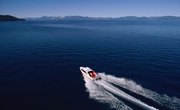
Questions about adding a turbo to a motorcycle are not based on whether it's possible, but rather the degree of difficulty to make it happen. A turbo adds as much as 60 horsepower when installed correctly. When installed incorrectly, the bike may not even reach 60 miles an hour. Basic kits include the turbo unit, intake plenum and a boost pressure gauge. More expensive kits include electronic fuel injection, a high-pressure fuel pump and a tuned exhaust. With either type of kit, adding a turbo to a motorcycle requires a full complement of tools and mechanical expertise.
Items you will need
Turbo kit (year and model of your motorcycle)
Metric tools
Shop tools
Remove the rider's seat and gas tank. Detach the throttle linkage from the carburetors and remove the carburetors. Set the carburetors aside. Remove the exhaust header pipes and the muffler. Save all bolts, nuts, washers, clips and the muffler clamps.
Attach the provided turbo bracket to the frame tube at the front of the motorcycle's engine. Do not tighten the attachment bolts at this point.
Assemble the turbo boost unit, waste gate and exhaust headers provided in the kit. Tighten all bolts securely. Position the assembly at the exhaust manifold at the front of the engine. Adjust the bracket to align with the threaded studs on the turbo unit.
Put the new exhaust gaskets on the motorcycle's exhaust manifold. Temporarily bolt the headers to the exhaust manifold. Temporarily mount the turbo to the bracket. Support the back end of the exhaust header pipe in position with random lengths of wire looped around the motorcycle frame tubes.
Put the provided intake plenum gaskets on the intake manifolds where the carburetors were removed. Fit the intake plenum to the intake manifolds. Bolt the plenum in place.
Mount the new boost gauge at the instrument panel or handlebars. Route the provided booster gauge line from the gauge to the fitting on the waste gate. Select a route as far from the engine as possible to avoid overheating of the line. Attach the line to the gauge and the fitting on the waste gate.
Tighten the nuts that secure the turbo to the mounting bracket. Tighten the exhaust header bolts. Attach the provided air filter to the turbo unit.
Put the gaskets on each end of the provided intake air conductor line. Connect the line to the turbo and intake plenum.
Put new intake gaskets on each carburetor. Reattach the carburetors to the intake plenum and reattach the fuel line to the fuel pump. Reconnect the throttle linkage to the carburetors.
Mount the gas tank on the motorcycle. Connect the fuel line from the petcock to the fuel pump.
Reattach the muffler to the exhaust pipe using the saved muffler clamp. Reattach the rider's seat onto the motorcycle.
Warnings
- The added horsepower can be unexpected and dangerous. Take the time to become familiar with a turbo-charged motorcycle engine.
Tips
- Turbo kits and components vary. Contact the manufacturer if necessary to ensure the correct installation and boost pressure.
References
Tips
- Turbo kits and components vary. Contact the manufacturer if necessary to ensure the correct installation and boost pressure.
Warnings
- The added horsepower can be unexpected and dangerous. Take the time to become familiar with a turbo-charged motorcycle engine.
Writer Bio
William Machin began work in construction at the age of 15, while still in high school. In 35 years, he's gained expertise in all phases of residential construction, retrofit and remodeling. His hobbies include horses, motorcycles, road racing and sport fishing. He studied architecture at Taft Junior College.



